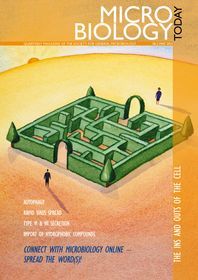The Ins and Outs of the Cell
02 May 2011 publication
The lead articles of the May 2011 issue of Microbiology Today are on autophagy; rapid virus spread; type VI and VII secretion; and the import of hydrophobic compounds.
‘Feed a cold, starve a fever’: autophagy and virus infection (p. 86)
Autophagy, the process whereby eukaryotic cells digest their own organelles and proteins, may have evolved as a mechanism to survive periods of starvation but, as Tom Wileman, Rebecca Roberts and Eleanor Cottam discuss, it is now becoming clear that this process also has an effect on virus pathogenicity.
A mechanism for rapid virus spread (p. 90)
How can a virus spread faster from cell to cell than seems possible based on its known rate of replication? Vaccinia virus takes at least 5–6 hours to produce the first new virus particles inside an infected cell and yet, remarkably, is able to spread across a lawn of susceptible cells at a rate of 1 cell every 1.2 hours. Geoffrey Smith explains that this paradox is explained by a novel mechanism in which the virus exploits cell biology to bounce across cells that are already infected and so find uninfected cells without the need to replicate in each cell along the way.
The bacterial type VI secretion system: on the bacteriophage trail (p. 96)
Secretion is fundamental to bacterial virulence. Of all the recognized secretion systems in Gram-negative bacteria, the type VI secretion system (T6SS) is of particular interest in this respect. Currently, we do not fully understand how the T6SS works, but it appears that its structural proteins are very similar to those that make up the injection machinery found in bacteriophages, as Alain Filloux reports.
Type VII secretion and the mycobacterial cell envelope (p. 102)
Although mycobacteria are phylogenetically related to Gram-positive bacteria, their cell envelope has a double-membrane structure more reminiscent of Gram-negative bacteria. Wilbert Bitter describes a novel secretion mechanism that has been identified in this unusual group of organisms, controversially classified as the type VII secretion system.
Moving forward laterally: outer-membrane transport of hydrophobic molecules (p. 108)
Hydrophobic molecules can cross the phospholipid bilayer of Gram-negative outer membranes very easily. Bert van den berg asks how is this achieved and how can we exploit this process for environmental clean-up?
SchoolZone (p. 112)
Donna Lecky describes the fun and free microbiology, hygiene and health educational resource ‘e-Bug’, and Vicki Symington looks at the role of new and social media in education.
Gradline (p. 118)
Stacey Munro reports on events at Harrogate designed to encourage effective communication, and Chris Thomson and Rob Hardwick describe the first few months of the newly formed UK Research Staff Association.
Outreach (p. 122)
SGM Education and Outreach Administrator Vicki Symington reports on two major science events in which SGM has participated recently – The Big Bang 2011 in London and the Brighton Science Festival in ... Brighton.
Going Public (p. 124)
Members report on various ways in which they have helped to spread the word about microbiology to the public.
Comment: Scientists and social media (p. 136)
Sociable scientists are successful scientists. Taking time to have a bit of a chat about your work can reap all sorts of benefits, according to Alice Bell.

